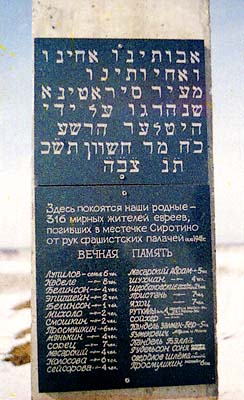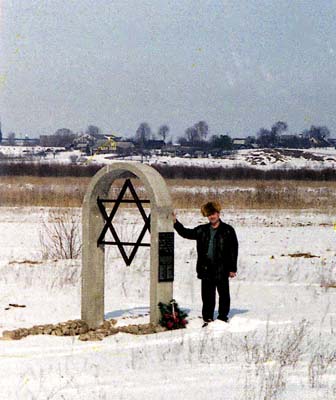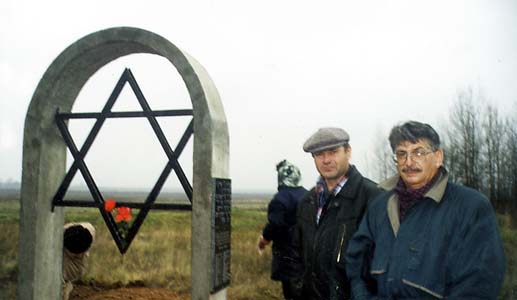

Project «Voices of Jewish settlements. Vitebsk region.»פיתוח קשרי התרבות בין העמים של ישראל ובלרוס
|
|---|
Website search |
|
MainNew publicationsContactsSite mapVitebsk regionMogilev regionMinsk regionArkady Shulman
|
FIFTY NINE YEARS LATER.On November 13th, 1941 fascists, together with their assistants, shot 316 Jews: children, women and old people, in a village called Sirotino in Vitebsk region. Among them there were too few men who could actually fight back. Some of the men had been mobilized to the Red Army; the rest had evacuated or joined the partisan movement.  Mikhail Rutkin
Mikhail Rutkinnext to the memorial to Jews, executed in Sirotino. Mikhail Naumovich Rutkin’s two brothers and sister are lying in the mass grave by the Gniloy Bridge. The elder one, Fridrik, was a little less than ten, the younger, Meir – only seven and the little Rachel was almost five. Their parents had been mobilized and the children were staying with their grandparents in Sirotino. They were hoping that the German army would not reach the village. And in any case they thought the Germans would not harm the peaceful residents of small villages. Many other families were shot together with the Rutkins. Right after the war Ruvim Masarsky, a courageous partisan, together with Naum Rutkin, who received the rank of a colonel, decided to set up a memorial on the site of the mass grave. On the stone stele they planned to chisel the Star of David and inside it the letters: “Here lie…” and then the text in Russian and Yiddish.  Mikhail Rutkin and Boris Khesin
Mikhail Rutkin and Boris Khesinnext to the memorial to Jews, executed in Sirotino. Those were the times of repressions and they were advised: “Do not do this – the dead will not come back and you will suffer.” The two men still insisted the stele should look like that. However, they were not destined to set up the memorial on the mass grave… Naum Rutkin was arrested in Leningrad – the officer, who had participated in three wars – the civil, the Finnish and the Patriotic war, was declared a “public enemy”… The stele was finally set up at the beginning of the 60s. Of course, it was a sincere intention, but there existed certain unofficial bans on national symbols and on the Jewish language, so the memorial looked faceless. Naum Rutkin died tragically in the middle of the 60s. This religious man was one of those who did not let the Jewish tradition of Vitebsk decline. While looking through his father’s papers, Mikhail Rutkin found the sketch of the old memorial. The sketch of a new memorial was created by Boris Khesin, an artist. It represents an arch with Magen David inside. The arch has a plate with an inscription in Russian and Hebrew and below it - the names of the genocide victims. The whole construction is made of concrete and metal. Mikhail Rutkin himself financed this project and solved all the questions, connected with it. Fifty-nine years after the execution of the 316 Sirotino Jews a memorial was erected by the people, who were born after the war. Arkady Shulman |
|||
|
|
Jewish settlements in Vitebsk regionVitebsk • Albrehtovo • Babinovichi • Baran • Bayevo • Begoml • Beshenkovichi • Bocheikovo • Bogushevsk • Borkovichi • Braslav • Bychiha • Chashniki • Disna • Dobromysli • Dokshitsy • Druya • Dubrovno • Glubokoye • Gorodok • Kamen • Kohanovo • Kolyshki • Kopys • Krasnopolie • Kublichi • Lepel • Liady • Liozno • Lukoml • Luzhki • Lyntupy • Miory • Obol • Oboltsy • Orsha • Osintorf • Ostrovno • Parafianovo • Plissa • Polotsk • Prozorki • Senno • Sharkovshina • Shumilino • Sirotino • Slaveni• Smolyany • Surazh • Tolochin • Ulla • Verhnedvinsk • Vidzy • Volyntsy • Yanovichi • Yezerishe • Zhary • Ziabki • |
Main |
New publications |
Contacts |
Site map |
Vitebsk region |
Mogilev region |
Minsk region |